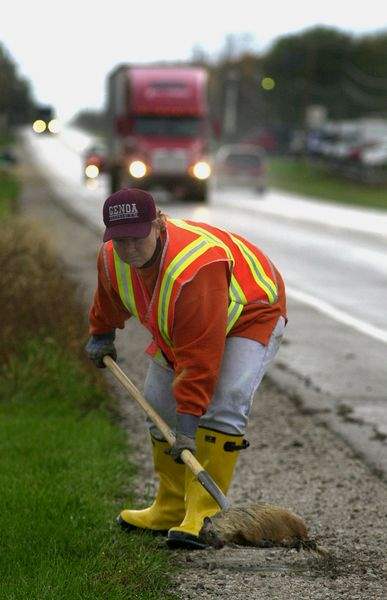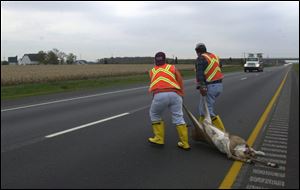
Roadkill part of life cycle in an age of automobiles
11/8/2001
Brenda Vincent with the Ohio Department of Transportation scoops up a dead animal along U.S. Rt. 20, above, then helps Brian Amos drag a long-dead deer to the edge of a cornfield along I-75, right, `so nature can take its course,' Ms. Vincent says.
THE BLADE
Buy This Image

Brenda Vincent with the Ohio Department of Transportation scoops up a dead animal along U.S. Rt. 20, above, then helps Brian Amos drag a long-dead deer to the edge of a cornfield along I-75, right, `so nature can take its course,' Ms. Vincent says.
Rain slaps her fur, but the raccoon grins, her gaze fixed on a spot somewhere farther down State Route 420. Her black leather hands reach out, but she doesn't feel a thing.
The square-nose shovel slides down easy in Brian Amos's practiced hands. The Ohio Department of Transportation worker separates the animal from the pavement, lifts it up, turns. Its trademark black-striped tail hangs off the shovel, waving in rhythm to Mr. Amos' steps. He walks down the embankment, over to a line of trees, and tosses the creature into the undergrowth.
Roadkill stinks. Somebody's got to deal with it.
“I'm a fireman. I've smelled it all,” Mr. Amos says. “This doesn't bother me any.”
“It's icky, but it's a fact of road maintenance: Animals get hit on roads. We take care of the problem,” said Joe Rutherford, spokesman for Ohio Department of Transportation's District 2 office in Bowling Green. “Roadkill is part of the `circle of life,' you know. The Lion King and all that.”

Brenda Vincent helps Brian Amos drag a long-dead deer to the edge of a cornfield along I-75, right, `so nature can take its course,' Ms. Vincent says.
It's true, in some cases: Strike a deer in any of eight area counties with your Mercury Cougar, and within hours it can be dinner for a real-life mountain lion.
The speeding Impala vs. waddling opossum contest is a new natural phenomenon, a byproduct of the automobile age. No one knows exactly how many animals die on local roads, but the Ohio Highway Patrol filed 26,898 deer-car collisions statewide in 2000.
Tiny creatures, or those that die on heavy traffic lanes, usually return to nature on their own. But bigger carcasses can be dangerous. They can block traffic, distract drivers, and offend the sensibilities of people who live nearby.
When a varmint meets its end along a state road or highway, ODOT gets the call. The Ohio Turnpike has carnage cleanup crews of its own. Within Toledo city limits, the job falls to the division of streets, bridges, and harbor.
“We'll get a call on the city hotline there's a dead squirrel or rabbit or raccoon somewhere. We'll tell the guy in the service truck, and he'll work it into his schedule when he's over that way,” said city department head Bill Franklin.
Equipment is simple: a pickup truck with a small hoist, a shovel, boots and gloves, and plenty of plastic bags.
“We try to get there fast, before it turns into a shovel job,” Mr. Franklin said. “Once it's smashed into the pavement, it's not only unsightly and unhealthy, it can draw more animals into the street. Animals are opportunistic. If someone else does the hunting for them, they'll be right there to eat the kill. And lots of times, they're the next one hit.”
If the victim is “a little, loose animal,” a squirrel or a raccoon, he'll go into a metal box. If it's really big, he goes under a tarp in the back of the truck.
“We don't get many deer in the city, but once we got a pot-bellied pig,” Mr. Franklin said. “We have the dogs and cats, porcupines, rabbits, raccoons, possums, birds, and squirrels. Especially squirrels. Toledo is a `Tree City U.S.A.,' you know. And squirrels are not bright.”
From January to Oct. 15, 2001, city trucks picked up 2,615 dead animals. Of these, 239 were former pets. Toledo's dead animals go to a special trash receptacle at the city landfill on Hoffman Road. When enough accumulate, they are interred in a deep burial area where they're safe from scavengers.
Out in the countryside, Mr. Amos and his fellow ODOT workers do things differently. Roadkill is picked up along with an assortment of interstate litter, much of it blown from the backs of tractor-trailer rigs, pickups, and campers.
Carcasses rarely make it onto the truck bed. Most are shoveled or carried off to the nearest roadside right-of-way and left to the elements. If there are houses or businesses nearby, the crew will sometimes bury the carcass, or perhaps haul it down the road to a lonelier place and leave it there.
A healthy deer can weigh up to 300 pounds, and a freshly killed animal holds a strong appeal to man and beast. One recent morning, Mr. Amos and his work partner, Brenda Vincent, were sent to I-75 just south of Perrysburg. State police reported a big buck had been struck in the wee hours.
The found the deer. Its head was gone, cut clean from the body that lay in the median.
“He must've had a nice rack of horns,” Ms. Vincent said. “Some hunter's going to be telling his friends some big, tall story about how he bagged this big guy.”
“Must've been a taxidermist took it,” Mr. Amos added. “If you're a hunter, you have to have a [hunting license] tag on it if you want it mounted.”
“That won't stop some people,” Ms. Vincent said.
Each worker took a front leg. They hauled the carcass up to the curb, waited for an opening in the howling traffic flow, and scurried across to the fence on the other side.
“He's smelling already. No good for the animal farm,” Mr. Amos said. “Too bad.”
“The Animal Farm” is Culbertson's Feeds & Pet Supplies in Springfield Township. John and Lois Culbertson are licensed to keep an assortment of wild animals rescued from disenchanted pet owners, including 14 big cats: lions, tigers, and cougars.
Road crews from the Ohio Turnpike and Department of Transportation bring freshly killed deer here, to feed the beasts. “They pull up alongside the building and just unload `em. It's not the most gorgeous sight in the world, but we're glad to see them,” said Lois Culbertson. “My son John does the butchering. He splits them into quarters and feeds them to the cats right away.”
The cats usually eat four or five chicken carcasses apiece at dinnertime, feathers and all. They need red meat in their diets, especially in winter, Mrs. Culbertson said. And they like the change. “It's a real help to us, and it would be a shame just to let all this meat go to waste,” she said. “This kind of meat would be a part of their diets, in the wild.”
Sometimes, road crews bring in five or 10 deer per week. Mr. Culbertson will drive as far as Swanton and Elmore to pick up a fresh kill. Other times of year, when deer are not on the move, only one or two will hit - and be hit on - the road.
Mr. Rutherford said his agreement with Culbertson's is “a handshake deal, unofficial. It saves us all time and money. It's a win-win situation.”
Unless you're a deer.